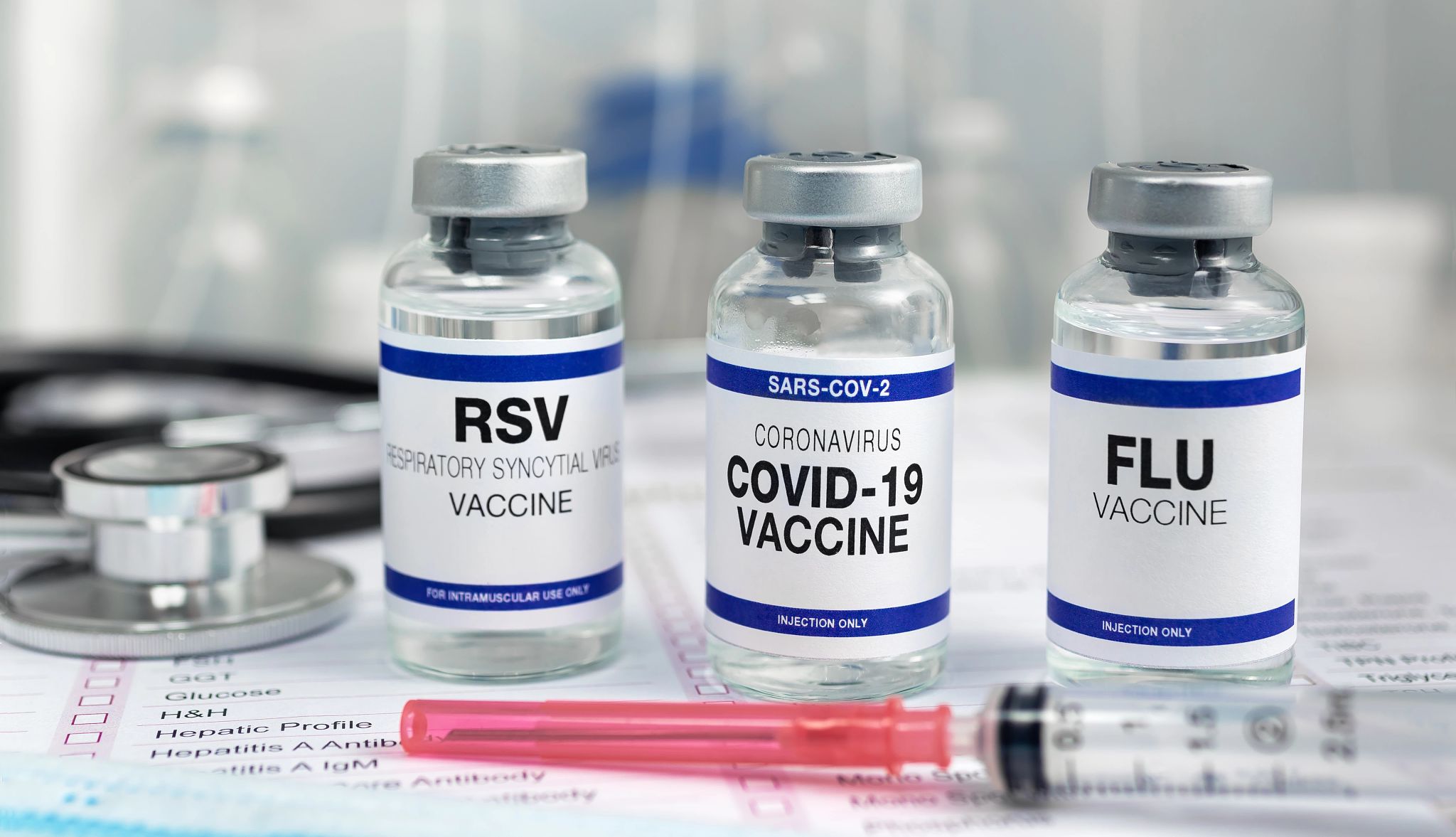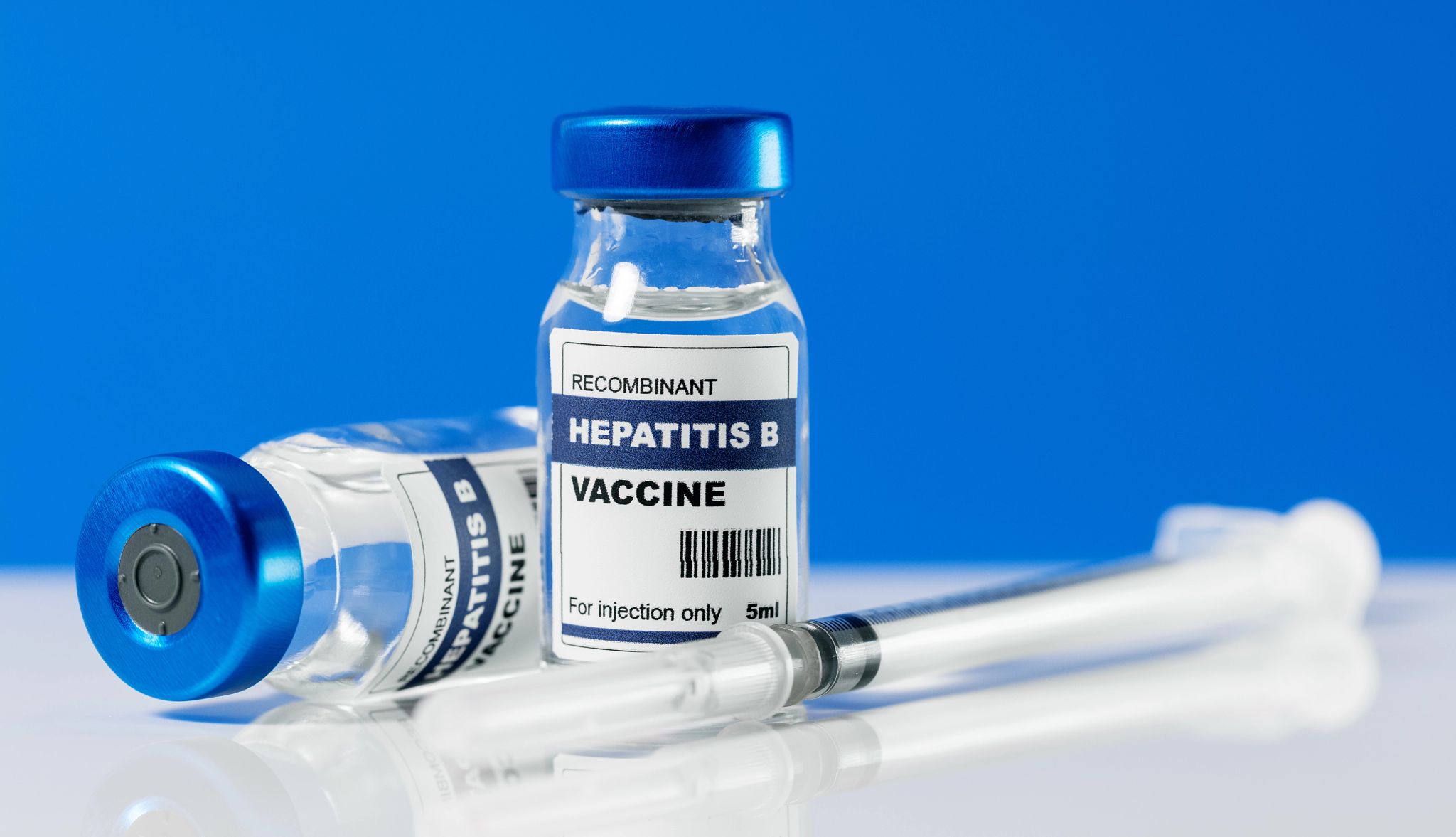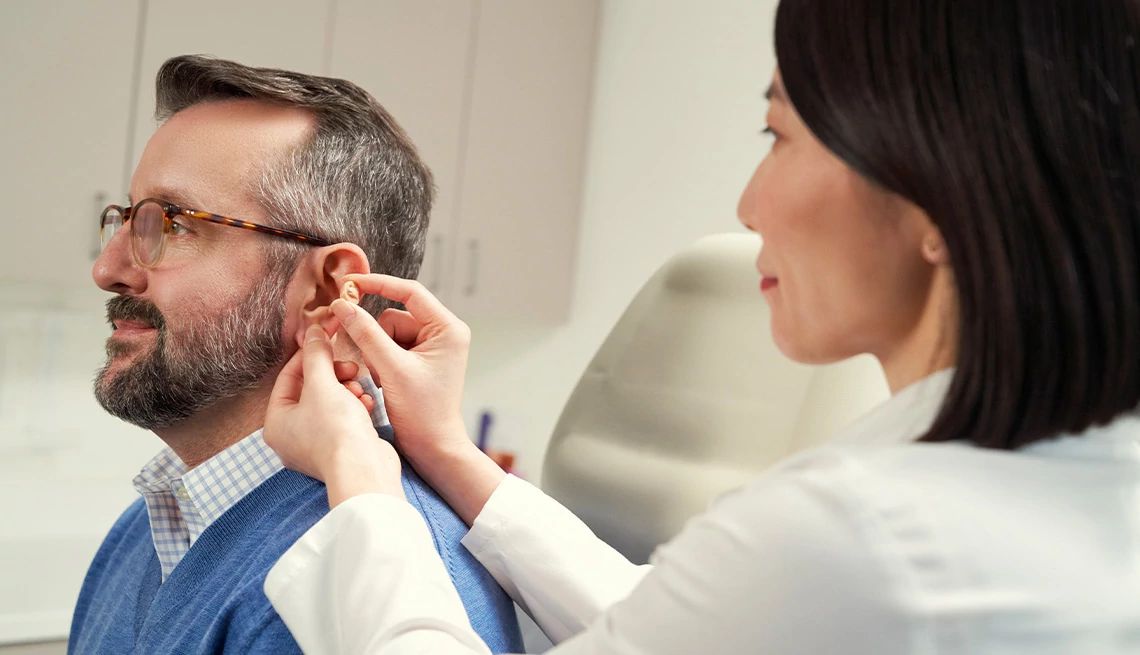
Everything you need to know, including when to get them, how to handle side effects and how to stay protected in

As you age, staying on top of your health is more important than ever, and that means doing everything you can to protect yourself from preventable illnesses. And the simplest, most powerful way to do that is to stay current on your vaccines.
Because your immune system naturally weakens with age, vaccines are a crucial line of defense against serious diseases such as shingles and pneumonia, says Robert Hopkins, M.D., medical director of the National Foundation for Infectious Diseases (NFID) and professor of internal medicine at the University of Arkans
Hopkins believes many older adults hesitate due to safety concerns and because they want more information. So here’s what you need to know about which vaccines you need, how they work, why they are safe, how to minimize side effects, and much more.


BENEFITS OF VACCINES FOR OLDER ADULTS
1. Why you need vaccines
Vaccines are a powerful tool of modern medicine, protecting you from diseases that once caused widespread suffering and death. For instance, according to the Infectious Diseases Society of America, the introduction of the measles vaccine in 1963 led to a 97 percent drop in cases between 1965 and 1968, and according to the World Health Organization, measles vaccination saved an estimated 60 million lives between 2000 and 2023..
“The reason why so many of us are healthy is because of vaccines,” says Sharon Brangman, M.D., chair of the department of geriatrics at SUNY Upstate Medical University in Syracuse, New York, and co-principal investigator for the American Geriatrics Society’s Older Adults Vaccine Initiative.
Rolling up your sleeve protects your health and contributes to herd immunity, safeguarding vulnerable populations like infants and those with weakened immune systems.
2. Your immune system weakens with age
As we age, our immune system naturally weakens in a process called immunosenescence, Brangman explains. Older adults are also more likely to have other health conditions such as diabetes, heart disease or high blood pressure that make it harder for the body to fight infection. Those changes put older adults at higher risk from common illnesses like influenza and pneumonia, potentially leading to severe complications or even death. That’s why it’s crucial for older adults to get all of their shots on time, Brangman says.
3. Vaccines reduce the risk of complications
Even when vaccines don’t prevent illness completely, they significantly reduce the likelihood of serious complications. A 2021 study conducted by the Centers for Disease Control and Prevention (CDC) found that hospitalized adults who got the flu vaccine were 26 percent less likely to be admitted to the intensive care unit and 31 percent less likely to die from the flu compared to those who were unvaccinated.
4. Vaccines may help prevent dementia
In addition to protecting you from the near-term impacts of diseases, a growing body of research suggests vaccines may help stave off dementia. In a 2022 study, University of Texas researchers found that getting an annual flu shot was associated with a 40 percent decrease in the risk of developing Alzheimer’s disease. And a 2021 study, published in The Journals of Gerontology, Series A: Biological Sciences and Medical Sciences, found that the Tdap vaccination was associated with a 42 percent lower dementia risk. “These viruses cause inflammation of the nerves in the brain,” Brangman explains, and that can “start the process of nerve cell death, which is what happens in Alzheimer’s disease."
5. Vaccines may lower heart attack and stroke risk
Research suggests vaccines may also lower the risk of cardiovascular events like heart attacks and strokes. A 2022 JAMA Network Open meta-analysis of six studies covering more than 9,000 patients showed that people who received a flu vaccine had a 34 percent lower risk of a major cardiovascular event over the next 12 months. Another study, published in January 2024, found that older adults who got the most recent COVID-19 booster shot had a 47 percent lower risk of strokes, blood clots and heart attacks compared to those who just received the original vaccine. Vaccines help lower inflammation, a key contributor to heart disease.
6. How vaccines work
Scientists have developed various types of vaccines to fight disease. Although they work in different ways, they all spark an immune response, training your body to protect itself against harmful germs. Here are the most common types of vaccines in the U.S.:
- Inactivated vaccines, like most flu vaccines, contain viruses that are killed or inactivated.
- Live attenuated vaccines, like the measles, mumps and rubella (MMR) vaccine, use weakened forms of the virus to boost immunity.
- Subunit, recombinant, polysaccharide or conjugate vaccines use specific pieces of the germ, such as its protein or casing, to help your immune system recognize and fight it. Examples include shingles, Hepatitis B and pneumonia vaccines.
- Messenger RNA (mRNA) vaccines, such as the Moderna and Pfizer/BioNTech COVID-19 vaccines, use genetic material to instruct cells to produce a protein that triggers an immune response.


UNDERSTANDING THE SCIENCE
7. Vaccines are rigorously tested and monitored for safety
All approved vaccines — including those that receive emergency authorization from the Food and Drug Administration (FDA) — undergo extensive study and review before they are allowed to be used, says Gregory Poland, M.D., an infectious disease physician at the Mayo Clinic in Rochester, Minnesota, and director of Mayo’s vaccine research group. This was the case specifically with the COVID-19 vaccine. Manufacturers must conduct clinical trials on thousands of people and prove the vaccine works for different groups, including breakdowns by sex, race/ethnicity and age. The data is then examined by a panel of scientific advisers who make recommendations to the FDA and the CDC.
After approval, federal agencies continue to monitor vaccines for any adverse effects, using multiple systems that scrutinize different types of data to ensure safety, Poland says. America’s safety monitoring systems “are the best that I know of in the world,” Poland says, “because there’s a series of them, and there’s some redundancy built into them, so you don't get a bias.” Poland notes that the systems quickly picked up on a rare side effect, a certain type of heart inflammation, in adolescent boys who had received the COVID vaccine — proof, he says, that the system worked.
8. Getting a vaccine is safer than getting sick with the disease
You’re much more likely to be seriously harmed by a vaccine-preventable disease than by a vaccine, Brangman says. Consider it: Shingles can cause blindness, long-term nerve damage and brain inflammation; tetanus can cause painful muscle spasms, difficulty breathing and blood clots; and respiratory illnesses like the flu or pneumonia can be deadly for older adults. Without vaccines, we’d see far more hospitalizations and deaths, according to Brangman.
9. No association between vaccines and autism
There is no evidence of a link between any vaccine and autism or autistic disorders, Hopkins says. A single study, which has since been discredited, reported such an association in 1998 in a British medical journal called The Lancet. Twelve years later, in 2010, The Lancet retracted the study, saying several elements of the paper were false.
The original study included only 12 children who were carefully selected by the researchers, according to a 2010 investigation by Britain’s General Medical Council. The council also found that study author Andrew Wakefield’s research was funded by lawyers acting for parents suing vaccine manufacturers. Saying Wakefield acted “dishonestly and irresponsibly,” the council found him guilty of serious professional misconduct.
Since Wakefield’s study, the misconception that vaccines cause autism “has been debunked with multiple studies,” Hopkins says. Dozens of well-designed analyses published in medical journals such as The New England Journal of Medicine, PLos One and The Lancet have found no increased risk of autism from vaccination.
10. Serious side effects are extremely rare
Serious side effects after vaccination are extremely rare, says Poland. For example, a 2021 study found the rate of myocarditis, or inflammation of the heart muscle, was 5.8 cases of myocarditis per million second COVID-19 doses in adults. Other studies show that the risk of myocarditis from contracting COVID-19 is significantly higher, and that the vast majority of people who develop myocarditis after vaccination fully recover. Medical providers say the overall benefits of vaccination far outweigh these minimal risks.
11. The vaccine can’t give you the disease it prevents
The vaccines recommended for older adults in the U.S., including those for COVID-19, pneumonia, shingles and the flu, do not contain the live virus, so it’s impossible to get the disease from those shots, Brangman says. One influenza vaccine approved for use in the U.S. contains a live and weakened virus — the nasal spray vaccine called FluMist — but it is not recommended for those who are 50 and older.
12. Not all reported health issues are caused by vaccines
The Vaccine Adverse Event Reporting System (VAERS) gives people a place to report health issues after vaccination, regardless of whether the vaccine caused the problem. While anti-vaccination groups use VAERS data to spread misinformation, the system is not designed to prove vaccines cause harm. Instead, it serves as a “canary in the mine” for potential side effects that require further investigation, Poland says. “It gives us a real-time quick snapshot if there is a potential problem. It doesn’t tell us there is a problem.” VAERS reports can be inaccurate, duplicated or incomplete, and events may be coincidental, so vaccine researchers say you shouldn’t draw conclusions from their data.
ARTICLE CONTINUES AFTER ADVERTISEMENT


KEY VACCINES FOR ADULTS OVER 50
14. COVID-19 vaccine
The CDC recommends everyone 6 months and older get the updated 2024–2025 COVID vaccine. The shots — from Moderna, Pfizer/BioNTech or Novavax — target a more recent variant of the virus and can boost waning immunity. Even though many people may want to put the pandemic in the rearview mirror, COVID-19 is “still causing thousands of hospitalizations and deaths every year,” Hopkins says, and the vast majority are older adults. If you’re 65+ or immunocompromised, the CDC recommends getting a second shot six months after your first dose
15. Influenza vaccine (high-dose or adjuvanted version for 65+)
Everyone 6 months and older should get a flu shot every year, the CDC advises, and it’s especially important for older adults. Fifty to 70 percent of flu-related hospitalizations occur among people 65 and older, according to the CDC, and 70 to 85 percent of flu-related deaths occur among this age group. The CDC recommends that adults 65 and older get either the high-dose or adjuvanted version of the vaccine for extra protection. Both are formulated to stimulate more antibodies to fight influenza. (Here’s more you need to know about the 2024–2025 flu vaccine.)
16. RSV vaccine
RSV, short for respiratory syncytial virus, is a virus that typically causes mild, cold-like symptoms, but the illness can be severe for older adults and infants. Each year, RSV is responsible for up to 160,000 hospitalizations and up to 10,000 deaths among adults ages 65 and older in the U.S. For 2024–2025, the CDC recommends the RSV vaccine for people 75 and older and for people ages 60 to 74 who live in nursing homes or have certain chronic health issues, like lung or heart disease, that put them at higher risk for severe illness. If you’re unsure if you should get the RSV vaccine, talk to your doctor. (If you received an RSV vaccine already, the CDC does not recommend getting another one at this time.)
17. Pneumonia (pneumococcal) vaccine
This vaccine helps protect you against pneumococcal disease, which can cause pneumonia, meningitis and other infections. Pneumonia leads to approximately 1.4 million emergency-room visits each year in the U.S., and older adults are more likely to die from it. In October 2024, the CDC lowered the initial age at which U.S. adults are recommended to get vaccinated against pneumococcal disease from 65 to 50 years. If you’ve already had a pneumococcal vaccine, ask your provider whether you need a second dose. (Here are 5 reasons to get a pneumococcal vaccine.)
18. Shingles vaccine (Shingrix)
Another vaccine the CDC says everyone age 50-plus should get is Shingrix, the shingles vaccine. Caused by the same virus as chickenpox, the shingles virus manifests as an angry, blistering rash, and in serious cases can cause blindness, brain inflammation and other complications. About 1 in 3 Americans will get shingles, with the risk of complications increasing sharply over age 60. The Shingrix vaccine requires two doses, spaced two to six months apart. Shingrix is recommended even if you previously received the older Zostavax vaccine.
19. Tdap vaccine or booster
This shot protects against tetanus, diphtheria and whooping cough, also known as pertussis. The CDC recommends getting a Tdap or Td shot every 10 years. With whooping cough cases on the rise, it’s a good time to make sure you’re up to date on this vaccine. If you aren’t sure when your one vaccine was, go ahead and get it anyway, Hopkins says. “We know getting multiple doses of that vaccine is safe.”


VACCINES THAT SOME OLDER ADULTS NEED
20. Hepatitis B vaccine
This vaccine helps protect you from hepatitis B, a liver infection that can cause chronic liver disease and liver cancer. In 2023, the CDC expanded its guidelines to recommend this shot for all adults younger than 60 who never received the shot as a child. (You can ask your health care provider to screen you to see if you are already immune to the virus.) The shot is also recommended for those age 60 and older who are at higher risk. That includes those with potential exposure to bodily fluids such as health care workers, sexually active people who aren’t in a long-term, monogamous relationship, people on kidney dialysis and those who inject drugs. Diabetics ages 60-plus should talk to their health care provider about whether to get the vaccine.
21. Hepatitis A vaccine
The CDC recommends the hepatitis A shot for adults who are at increased risk for it, including people with chronic liver disease, men who have sex with other men, homeless populations, people who have HIV, those who use or inject illegal drugs, those who work in areas with a risk of infection, and travelers to countries where hepatitis A is common.
22. Measles, mumps, rubella (MMR) vaccine
With measles cases increasing in the U.S., it’s important to make sure you’re protected. Most older adults are immune because they either received the MMR vaccine as a child or were born before 1957, when measles was prevalent. If you don’t have presumed immunity, the CDC suggests getting at least one dose of the MMR vaccine. If you have a weakened immune system, consult with your doctor about whether to get immunized.
23. Vaccines for travel
Before traveling abroad, check the CDC’s travel destination pages for travel health information and to see if your destination requires specific vaccines. Some countries recommend or mandate immunizations for diseases like yellow fever, typhoid or hepatitis. Because some vaccines require multiple doses, it’s best to see your health care provider or visit a travel clinic as soon as possible. Make sure to bring a copy of your official immunization records with you when you travel.
24. Catch-up vaccines
If you don’t remember if you had a vaccine, the CDC advises reaching out to your parents and caregivers to see if they have your child immunization records, or if they can check baby books and school records from your childhood. You can also ask former health care providers and previous schools or colleges (or the military) if they keep immunization records. Some city and state health departments have registries of vaccination information, but they may not include all ages or all records. If you are unable to find a record of vaccination, ask your doctor if there is a blood test that would indicate if you have immunity to a particular disease. If not, there is no harm in repeating a vaccine, Hopkins says
SCHEDULING YOUR VACCINATION
25. Clear your calendar
Consider scheduling your vaccine before a weekend or a few days when you don’t have much planned. That way, you have time to rest and recover from any side effects before you return to work or a busy schedule.
Some medications that suppress the immune system, such as steroids or cortisone shots, can reduce vaccine effectiveness. One Mayo Clinic study of more than 15,000 patients found that those who received steroid shots a few weeks before the flu vaccine experienced a reduction in vaccine effectiveness. The American Academy of Orthopaedic Surgeons recommends avoiding steroid injections two weeks before and one week following COVID vaccine administration. Hopkins suggests following the same guidelines for other vaccines to ensure maximum effectiveness.
26. Consider scheduling multiple vaccines at the same time
Getting several vaccines at the same time is safe, the CDC says. For example, if it’s more convenient for you, you can get your flu, COVID-19 and RSV vaccines in the same visit. The agency suggests getting them in different limbs or ensuring the injection sites are at least an inch apart. While some may worry that too many vaccines could overwhelm the body’s immune system, Hopkins says that’s not possible. However, you could experience greater side effects. “You may feel worse if you get multiple vaccines at one time, but there’s no additional danger,” he says.
27. Get your flu shot in October, if possible
Getting the flu shot anytime during the respiratory virus season is better than not getting it at all, but if you get vaccinated in July or August, your vaccine immunity might wane before the flu season ends in May. The CDC recommends scheduling your shot for September or October, since the flu season typically starts in October or November.
28. Consult your provider if you have a chronic illness or complex health history
If you have a complex medical history or an illness such as lung disease, chronic kidney disease or uncontrolled diabetes, you should talk to your doctor about the best way to schedule your vaccinations to maximize their effectiveness, Brangman says. Also talk to your provider if you’re managing a condition that requires immune-suppressing medications such as cancer, rheumatoid arthritis, HIV, lupus or inflammatory bowel disease. Taking an immune-suppressing drug is a double-edged sword, Brangman says, because “it makes you more vulnerable to an infection because your immune system isn’t working, but it also may make your body not have an optimal response to a vaccine. You have to talk with your doctor and see what they suggest.”
29. Avoid over-the-counter pain relievers before a vaccine
Over-the-counter pain relievers like ibuprofen (Advil, Motrin) and acetaminophen (Tylenol), taken before you get jabbed, may decrease your response to a vaccine, Hopkins says. However, you should still take your regular prescribed medications the day of your appointment, and you can take a pain reliever after your shot if you experience side effects. (Here’s a list of drugs that interact with the flu shot.

TAKE THE STING OUT OF SHOTS
30. Choose which arm to get the injection in
Many people opt for their nondominant arm. However, if you’re a side sleeper, you may want to avoid the arm on the side that you sleep. If you are getting more than one vaccine at a time, your provider should alternate arms.
31. Relax your arm
If you’re afraid of needles, you’re not alone — 20 to 30 percent of adults have some level of fear when it comes to getting poked. But there are ways to make vaccinations easier. Start by keeping your arm limp and relaxed, suggests Stefan Friedrichsdorf, M.D., a professor at the University of California at San Francisco who has studied ways to ease vaccine pain. If you inject into a tense muscle, “the pain will just stay longer,” he says. To help your body relax, try slowly breathing in through your nose and out through your mouth. Deep breathing not only helps you stay calm but also acts as a useful distraction, Friedrichsdorf says. Moving your arm after the shot will also help disperse the liquid (injectate) put in your muscle and, in turn, help with muscle soreness.
32. Ease the sting with numbing cream
Apply 4 percent lidocaine cream to the area at least 30 minutes before your shot, Friedrichsdorf suggests. A 2024 review of nine studies published in the journal Vaccines found that the cream significantly reduced pain in children receiving vaccines, and Friedrichsdorf says it works for adults, too. You can get the cream at any drugstore, Friedrichsdorf says, but be sure to ask your provider ahead of time where the shot will be administered so you can apply it to the right spot.
33. Distract yourself
Friedrichsdorf says how much pain you feel often depends more on your expectations and fear than the actual shot. To shift your focus when you’re getting a vaccine, find something to keep your mind off what’s happening. Use your phone to play a quick game, scroll through social media, or make small talk with the provider.
34. Skip the countdown
Some vaccine providers count down from three before giving a shot, but Friedrichsdorf recommends asking them to refrain. “That heightens stress and anxiety,” he says. “Tell the provider, ‘Don’t count to three. Just do it.’”
35. Suck on something sweet
Research shows giving infants just one drop of sugar water eases vaccine pain. Friedrichsdorf isn’t aware of similar studies in adults but recommends eating candy or chocolate because sugar releases endorphins, which activate the nervous system to reduce pain signals. Friedrichsdorf says his hospital offers chocolate when he gets his flu shot, adding, “I find it particularly helpful.”
36. Check for proper technique
Some health care providers receive only limited training on how to administer intramuscular vaccines, Poland says, and an incorrectly administered shot can lead to unnecessary pain and side effects. The injection should be given about three finger widths below the bony tip of your shoulder, just above the top of your armpit, and on the side of your arm — not the front or back, he says. The needle should be inserted at a 90-degree angle to the floor, and the provider shouldn’t pinch your skin beforehand. “I actually mark my arm and arms of my family members,” Poland says.


m an ice pack, others prefer something warm. Use the method that works best for you.
39. Keep your arm moving to ease soreness
After getting your shot, keep your arm active. Simple moves like arm circles and shoulder rolls can increase blood flow to the injection site, potentially easing discomfort and stiffness, Poland says.


OTHER VACCINE TIPS
40. Try moderate exercise to enhance a vaccine’s effects
If you feel up for it, doing some mild or moderate exercise after vaccination may boost your body’s immune response, according to a 2022 study published in the journal Brain, Behavior and Immunity. Try going for a brisk walk or bike ride, or taking a yoga class.
41. Check out the CDC’s adult vaccine schedule
Having trouble keeping track of which vaccines you should get and when? The CDC offers a helpful vaccine schedule for adults. A printable chart outlines the recommended vaccines for each age group, along with guidance for special populations such as the immunocompromised. In addition, AARP’s vaccines for older adults page can help you stay on top of vaccine-related news and changing vaccine guidelines for those over 50.
42. Log your symptoms
Report side effects that are concerning to you to VAERS. You can log any health problem you experience after vaccination, even if you are not sure if the vaccine caused the event. If it looks as though a vaccine might be associated with a health problem, the CDC and FDA will investigate further and take action if needed.
43. Track your vaccines
Keeping a record of which vaccines you’ve received can help you avoid unnecessary doses and remember when your next one is due. These days, your immunization history is typically part of the electronic medical record kept by your health care provider, but Hopkins says it’s also a good idea to keep your own copy. You can print and fill out this tracking form from the CDC, use an app like Docket Immunization Records or SMART Health Card (used by many pharmacies, health care providers and more than 25 states and U.S. territories), or simply keep your own list in the Notes app of your phone.
VACCINE ACCESS
44. Where to get vaccines
Vaccines are widely available at doctor’s offices, pharmacies, grocery stores, big-box stores and health clinics. Many providers even offer incentives, such as discounts or coupons, to encourage vaccination. For example, CVS sometimes offers $5 off a $20 store purchase for every vaccine you receive, while Walgreens offers a coupon for 20 percent off your next purchase of $20 or more for myWalgreens members. If you need a COVID-19 vaccine, AARP provides state-specific vaccine guides that can help you find a location near you. For other vaccines, check the manufacturer’s website for locator tools. For example, Sanofi offers a tool to help you find its high-dose flu shots, Fluzone and Flublok.
45. How to pay for vaccines
- If you have private health insurance: Generally speaking, you shouldn’t have to pay out of pocket for recommended vaccines as long as you get them from an in-network provider, but you should check with your plan before you go.
- If you have traditional Medicare: Medicare Part B covers many vaccines as a free preventative service, including the shots for COVID-19, influenza, pneumonia, plus hepatitis B for people at medium or high risk for the virus. People with a Medicare Part D prescription drug plan can get the vaccines for RSV, shingles, Tdap, hepatitis A and hepatitis B (for those at low risk) at no cost.
- If you have a Medicare Advantage Plan: Medicare Advantage plans are required to cover all Part B preventive services (above) at no cost to you when you visit an in-network provider. However, you may incur charges if you use an out-of-network provider. If your Medicare Advantage plan includes prescription drug coverage, it must also fully cover the CDC-recommended Part D vaccines (listed above).
- If you have Medicaid: Under the prescription drug law signed in 2022, state Medicaid programs are required to cover federally approved vaccines that are recommended by the CDC’s Advisory Committee on Immunization Practices.
- If you don’t have insurance: Adults without insurance may be able to find free or low-cost vaccines at some federally qualified health centers or state or local health departments, but supply can be limited. Use the National Association of County & City Health Officials’ health department directory to find one in your area. You can also investigate vaccine-assistance programs.


Sign up for the latest health news, fitness and nutrition updates and moral


Nearing Retirement, She Fears Outliving Her Mone
Her financial security requires hard numbers and some thoughtful guesswork


10 Reasons Long-Term Marriages End in Divorce
It's not just celebrities who are splitting up after decades together


10 Ways to Get Rid of Pesky Age Spots
Banish brown spots on face or body with in-office or at-home treatmentBanish brown spots on face or skin with in-office or at-home treatment
ARTICLE CONTINUES AFTER ADVERTISEMENT


Free on-demand Pilates classes led by certified instructors








Heart Health Secrets from a Cardiologist